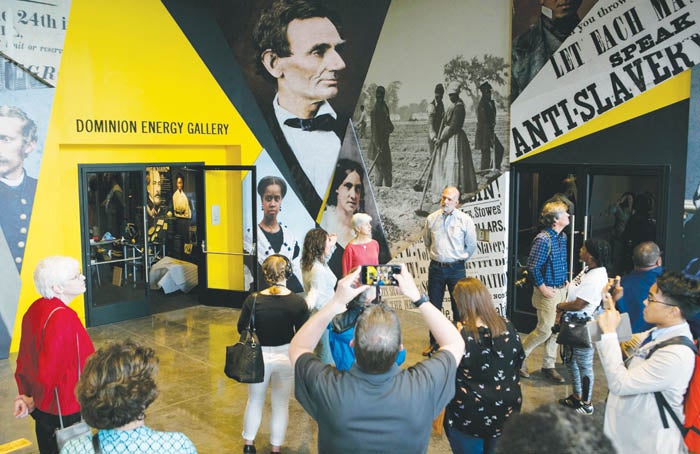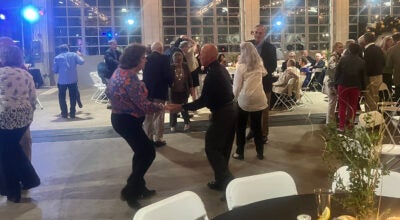New museum aims to tell broader history of Civil War
Published 12:00 am Saturday, April 27, 2019

- Reporters tour the American Civil War Museum in Richmond, which is set to open next weekend. Julia Rendleman/Washington Post
By Gregory S. Schneider
The Washington Post
RICHMOND, Va. — Sheets of rain pounded the towering glass walls of this city’s new American Civil War Museum as workers raced to finish preparations for its opening next Saturday.
It seemed fitting for the Capital of the Confederacy — gray skies above, gray stone below, and across the lobby the ruined brick archways of the former Tredegar Ironworks.
But behind that ruin — artfully preserved as the centerpiece of the $25 million facility — the exhibits aim to shatter expectations of what a Civil War museum looks like.
Yes, there are all the artifacts you’d expect: Robert E. Lee’s hat. J.E.B. Stuart’s boots. A Confederate battle flag.
And there are “Hey, Mabel!” oddities: a fossilized biscuit from the siege of Vicksburg, a pocket journal split by a fatal bullet.
What’s different, though, is the story that they tell.
Museum chief Christy Coleman, curator Cathy Wright and their staffs and contractors have set out with the grandest of ambitions to reframe the way visitors view this crucial part of American history and the way that past continues to reverberate.
The project’s groundbreaking was a few days after the 2017 violent white-supremacist rally in Charlottesville. As it nears its unveiling, Charlottesville remains atop the national dialogue about race. And Virginia’s top elected official, Gov. Ralph Northam, is embroiled in a scandal about a blackface incident from his past.
The roots of those racial tensions, Coleman said, are exactly what the museum is trying to address. Not by highlighting division but by making the Civil War seem personal and relevant, as told by the stories of relatable people. That means including the perspectives of women and people of color from both North and South.
It’s all presented through displays that emphasize jagged fragments — a reconstructed house is literally blown to bits, its wooden siding erupting across the ceiling and morphing into angular video screens — and jarring colors. The motif “ties into the idea of a fractured nation,” Wright said Friday during a media preview tour of the facility, which is an expansion and merger of two older museums.
“We … wanted people to walk into something that maybe disoriented their expectations of the Civil War story,” said John Murphy of Solid Light, the company that designed the exhibits.
One of the original museums that has been incorporated into this new venue was attached to the White House of the Confederacy, where Jefferson Davis plotted the war with his generals. That facility had one of the most extensive collections of Confederate artifacts in the world, assembled in the years after the Civil War by women from each state in the South who wanted to commemorate their “Lost Cause.”
While the old building had 250 items on permanent display, the new one has 550. There are nearly 15,000 more in storage.
Though the Confederate museum had tried to expand its depiction of history, showcasing contributions of women and enslaved people, it was tethered to a traditional presentation: North and South, slavery and freedom.
“We want to get away from the myth-making and back to history,” said Coleman, who helped lead the creation of the institution.
The new galleries show women as well as people of Native American, Asian and Hispanic descent, and free and enslaved black people, alongside the usual white male generals.
Many of the photographs have been colorized in an attempt to bring them to life. The result is surprising, like seeing modern people cast back into historical settings.
An imposing, wall-size photograph in one gallery shows eight of Virginia’s members of Congress from the postwar 1870s — and all of them are black. They gaze across the room at an iconic painting of Lee and Gen. Thomas “Stonewall” Jackson in their last encounter.
Many of the museum’s stories are aimed at defying conventional ideas about the war. Wives who pushed their husbands to fight the Yankees in 1861, for instance, sometimes decided a few years later it wasn’t worth it. Some slaves initially feared leaving their plantations, where life seemed relatively safe.
Even some of the most conventional artifacts have surprising stories. One of the last galleries, set in 1865 amid the fall of Richmond, displays a square Confederate battle flag. This flag happens to have been captured in Richmond by Tad Lincoln, the president’s young son, when they visited two days after the surrender in 1865. Tad is said to have waved it from a window of the White House on his birthday, shortly before his father was assassinated.
The museum is in downtown Richmond near the James River, in what had been the heart of Southern industry. Tredegar Ironworks was the arsenal of the Confederacy, producing many of its big guns and locomotives. It survived Richmond’s evacuation fire and lasted until the 1950s.
With opening day drawing close, the museum is unfinished. Cardboard boxes line the floors, surrounded by power tools and clumps of hardware for display cases. Hand drills buzz, hammers tap and technicians scramble to finish exhibits. One woman carefully mounted discs holding locks of hair from John Wilkes Booth; a colleague worked near a tray holding a shoe, a canteen, a frying pan and other items found on a battlefield.
Coleman said it makes sense for Richmond to take a lead role in redefining the legacy of the Civil War. Virginia saw more battles and casualties than any other state, and today it has more Confederate monuments.
Coleman, who is African-American, helped lead a city commission to ponder the fate of the Confederate statues along Richmond’s signature Monument Avenue. The result was a plan that called for “context,” for presenting a more complete historical backdrop so the statues would lose any power as symbols of white dominance.
Richmond’s leaders haven’t figured out how to do that yet. But just across town from Monument Avenue, the American Civil War Museum is an audacious effort to show what that looks like.
“This is a story about us,” she said. “What this has been about is bringing together the narratives (of the Civil War). It isn’t just about Union and Confederate, or African-American and white. What this is is an American story that impacted people from shore to shore, and we don’t talk about that.”




